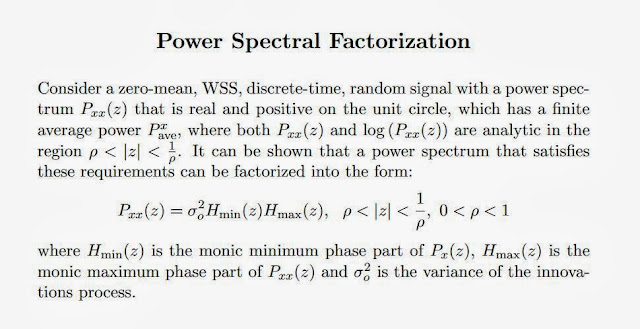1. Define discrete random process.
ans: A discrete time random process is a collection or ensemble of discrete time signals . A discrete time random process is a mapping from sample space Ω in to the set of discrete time signals x(n) .
2. When a random process is called as wide-sense stationary?
ans : A random process x(n) said to be wide sense stationary if the following conditions are satisfied
* The mean of the process is a constant Mx(n) = Mx
* The auto correlation rxx(k,l) depends only on the difference K-l
* The variance of the process is finite , Cx(0) < ∞
3. State Wiener – Khintchine relation.
ans : It states that the autocorrelation function of a wide-sense-stationary random process has a spectral decomposition given by the power spectrum of that process
Let X(n) be a real signal then rxx(l) <-> Sxx(ω)
4. State spectral factorization theorem.
ans:
5. Write down the properties of regular process.
ans : *any regular process may be realized as the output of a casual and stable filter that is driven by white noise having variance σ^2 * the inverse filter 1/H(z) is a whitening filter , that is if x(n) is filtered with 1/H(z) then the output is a white noise with variance σ^2
*since ν(n) and X(n) are related by in-veritable transformation ,either process may derived from the other ,therefore both contains same information
6. When a wide-sense stationary process is said to be white noise?
ans:
ans: A discrete time random process is a collection or ensemble of discrete time signals . A discrete time random process is a mapping from sample space Ω in to the set of discrete time signals x(n) .
2. When a random process is called as wide-sense stationary?
ans : A random process x(n) said to be wide sense stationary if the following conditions are satisfied
* The mean of the process is a constant Mx(n) = Mx
* The auto correlation rxx(k,l) depends only on the difference K-l
* The variance of the process is finite , Cx(0) < ∞
3. State Wiener – Khintchine relation.
ans : It states that the autocorrelation function of a wide-sense-stationary random process has a spectral decomposition given by the power spectrum of that process
Let X(n) be a real signal then rxx(l) <-> Sxx(ω)
4. State spectral factorization theorem.
ans:
5. Write down the properties of regular process.
ans : *any regular process may be realized as the output of a casual and stable filter that is driven by white noise having variance σ^2 * the inverse filter 1/H(z) is a whitening filter , that is if x(n) is filtered with 1/H(z) then the output is a white noise with variance σ^2
*since ν(n) and X(n) are related by in-veritable transformation ,either process may derived from the other ,therefore both contains same information
6. When a wide-sense stationary process is said to be white noise?
ans:
7. Write autocorrelation and autocovariance matrices.
ans :The autocorrelation matrix is used in various digital signal processing algorithms. It consists of elements of the discrete autocorrelation function, arranged in the following manner:
arranged in the following manner:
ans :The autocorrelation matrix is used in various digital signal processing algorithms. It consists of elements of the discrete autocorrelation function,
 arranged in the following manner:
arranged in the following manner:
autocovariance is the expected value of the ith entry in the vector X. In other words, we have
![\Sigma
= \begin{bmatrix}
\mathrm{E}[(X_1 - \mu_1)(X_1 - \mu_1)] & \mathrm{E}[(X_1 - \mu_1)(X_2 - \mu_2)] & \cdots & \mathrm{E}[(X_1 - \mu_1)(X_n - \mu_n)] \\ \\
\mathrm{E}[(X_2 - \mu_2)(X_1 - \mu_1)] & \mathrm{E}[(X_2 - \mu_2)(X_2 - \mu_2)] & \cdots & \mathrm{E}[(X_2 - \mu_2)(X_n - \mu_n)] \\ \\
\vdots & \vdots & \ddots & \vdots \\ \\
\mathrm{E}[(X_n - \mu_n)(X_1 - \mu_1)] & \mathrm{E}[(X_n - \mu_n)(X_2 - \mu_2)] & \cdots & \mathrm{E}[(X_n - \mu_n)(X_n - \mu_n)]
\end{bmatrix}.](http://upload.wikimedia.org/math/5/8/5/58572fa5b05e778f5a5eff9ec1b3ddb6.png)
- 8. Write the properties of autocorrelation matrix.
Property 1 : Autocorrelation matrix of a wss process is clearly a Hermitian matrix and a Toeplitz matrix
Property 2. Autocorrelation matrix of a wss process is non negetive definite Rx > 0 - Property 3 : The eigen values λk of Autocorrelation matrix of a wss process are real valued and non negetive
- 9. What are Ensemble averages?
10 . For given two random processes, x(n) and y(n), define cross-covariance and cross-correlation.
ans :


![\mathbf{R}_x = E[\mathbf{xx}^H] = \begin{bmatrix}
R_{xx}(0) & R^*_{xx}(1) & R^*_{xx}(2) & \cdots & R^*_{xx}(N-1) \\
R_{xx}(1) & R_{xx}(0) & R^*_{xx}(1) & \cdots & R^*_{xx}(N-2) \\
R_{xx}(2) & R_{xx}(1) & R_{xx}(0) & \cdots & R^*_{xx}(N-3) \\
\vdots & \vdots & \vdots & \ddots & \vdots \\
R_{xx}(N-1) & R_{xx}(N-2) & R_{xx}(N-3) & \cdots & R_{xx}(0) \\
\end{bmatrix}](http://upload.wikimedia.org/math/6/9/8/698a6881df8baf8fa22ab6b6173b18a4.png)
No comments:
Post a Comment